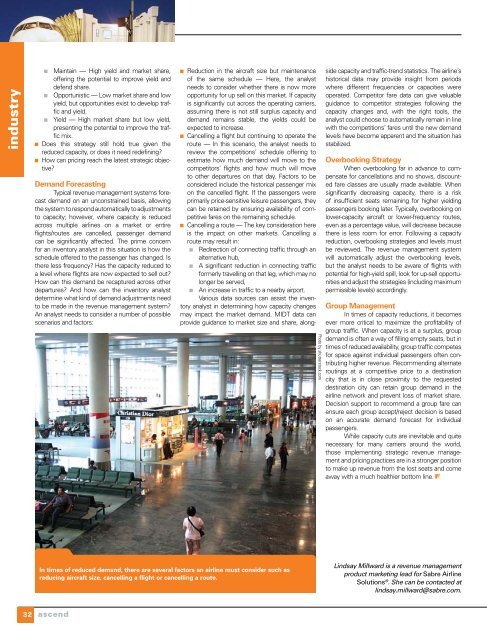2009 Issue 1 - Sabre Airline Solutions
2009 Issue 1 - Sabre Airline Solutions
2009 Issue 1 - Sabre Airline Solutions
You also want an ePaper? Increase the reach of your titles
YUMPU automatically turns print PDFs into web optimized ePapers that Google loves.
industry<br />
32<br />
Maintain — High yield and market share,<br />
offering the potential to improve yield and<br />
defend share.<br />
Opportunistic — Low market share and low<br />
yield, but opportunities exist to develop traffic<br />
and yield.<br />
Yield — High market share but low yield,<br />
presenting the potential to improve the traffic<br />
mix.<br />
Does this strategy still hold true given the<br />
reduced capacity, or does it need redefining?<br />
How can pricing reach the latest strategic objective?<br />
Demand forecasting<br />
Typical revenue management systems forecast<br />
demand on an unconstrained basis, allowing<br />
the system to respond automatically to adjustments<br />
to capacity; however, where capacity is reduced<br />
across multiple airlines on a market or entire<br />
flights/routes are cancelled, passenger demand<br />
can be significantly affected. The prime concern<br />
for an inventory analyst in this situation is how the<br />
schedule offered to the passenger has changed. Is<br />
there less frequency? Has the capacity reduced to<br />
a level where flights are now expected to sell out?<br />
How can this demand be recaptured across other<br />
departures? And how can the inventory analyst<br />
determine what kind of demand adjustments need<br />
to be made in the revenue management system?<br />
An analyst needs to consider a number of possible<br />
scenarios and factors:<br />
Reduction in the aircraft size but maintenance<br />
of the same schedule — Here, the analyst<br />
needs to consider whether there is now more<br />
opportunity for up sell on this market. If capacity<br />
is significantly cut across the operating carriers,<br />
assuming there is not still surplus capacity and<br />
demand remains stable, the yields could be<br />
expected to increase.<br />
Cancelling a flight but continuing to operate the<br />
route — In this scenario, the analyst needs to<br />
review the competitions’ schedule offering to<br />
estimate how much demand will move to the<br />
competitors’ flights and how much will move<br />
to other departures on that day. Factors to be<br />
considered include the historical passenger mix<br />
on the cancelled flight. If the passengers were<br />
primarily price-sensitive leisure passengers, they<br />
can be retained by ensuring availability of competitive<br />
fares on the remaining schedule.<br />
Cancelling a route — The key consideration here<br />
is the impact on other markets. Cancelling a<br />
route may result in:<br />
Redirection of connecting traffic through an<br />
alternative hub,<br />
A significant reduction in connecting traffic<br />
formerly travelling on that leg, which may no<br />
longer be served,<br />
An increase in traffic to a nearby airport.<br />
Various data sources can assist the inventory<br />
analyst in determining how capacity changes<br />
may impact the market demand. MIDT data can<br />
provide guidance to market size and share, along-<br />
In times of reduced demand, there are several factors an airline must consider such as<br />
reducing aircraft size, cancelling a flight or cancelling a route.<br />
ascend<br />
Photo by shutterstock.com<br />
side capacity and traffic-trend statistics. The airline’s<br />
historical data may provide insight from periods<br />
where different frequencies or capacities were<br />
operated. Competitor fare data can give valuable<br />
guidance to competitor strategies following the<br />
capacity changes and, with the right tools, the<br />
analyst could choose to automatically remain in line<br />
with the competitions’ fares until the new demand<br />
levels have become apparent and the situation has<br />
stabilized.<br />
overbooking strategy<br />
When overbooking far in advance to compensate<br />
for cancellations and no shows, discounted<br />
fare classes are usually made available. When<br />
significantly decreasing capacity, there is a risk<br />
of insufficient seats remaining for higher yielding<br />
passengers booking later. Typically, overbooking on<br />
lower-capacity aircraft or lower-frequency routes,<br />
even as a percentage value, will decrease because<br />
there is less room for error. Following a capacity<br />
reduction, overbooking strategies and levels must<br />
be reviewed. The revenue management system<br />
will automatically adjust the overbooking levels,<br />
but the analyst needs to be aware of flights with<br />
potential for high-yield spill, look for up-sell opportunities<br />
and adjust the strategies (including maximum<br />
permissible levels) accordingly.<br />
group Management<br />
In times of capacity reductions, it becomes<br />
ever more critical to maximize the profitability of<br />
group traffic. When capacity is at a surplus, group<br />
demand is often a way of filling empty seats, but in<br />
times of reduced availability, group traffic competes<br />
for space against individual passengers often contributing<br />
higher revenue. Recommending alternate<br />
routings at a competitive price to a destination<br />
city that is in close proximity to the requested<br />
destination city can retain group demand in the<br />
airline network and prevent loss of market share.<br />
Decision support to recommend a group fare can<br />
ensure each group accept/reject decision is based<br />
on an accurate demand forecast for individual<br />
passengers.<br />
While capacity cuts are inevitable and quite<br />
necessary for many carriers around the world,<br />
those implementing strategic revenue management<br />
and pricing practices are in a stronger position<br />
to make up revenue from the lost seats and come<br />
away with a much healthier bottom line. a<br />
Lindsay Millward is a revenue management<br />
product marketing lead for <strong>Sabre</strong> <strong>Airline</strong><br />
<strong>Solutions</strong> ® . She can be contacted at<br />
lindsay.millward@sabre.com.
















